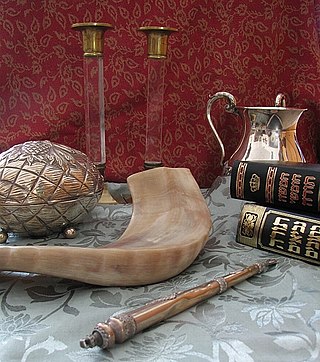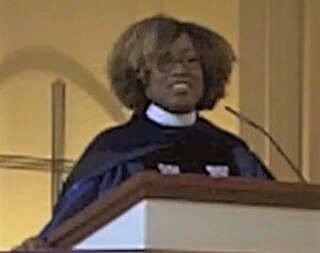Related Research Articles

The Book of Joshua is the sixth book in the Hebrew Bible and the Christian Old Testament, and is the first book of the Deuteronomistic history, the story of Israel from the conquest of Canaan to the Babylonian exile. It tells of the campaigns of the Israelites in central, southern and northern Canaan, the destruction of their enemies, and the division of the land among the Twelve Tribes, framed by two set-piece speeches, the first by God commanding the conquest of the land, and, at the end, the second by Joshua warning of the need for faithful observance of the Law (torah) revealed to Moses.

Yahweh was an ancient Levantine deity, and national god of the Israelite kingdoms of Israel and Judah. Though no consensus exists regarding the deity's origins, scholars generally contend that Yahweh emerged as a "divine warrior" associated first with Seir, Edom, Paran and Teman, and later with Canaan. The origins of his worship reach at least to the early Iron Age, and likely to the Late Bronze Age, if not somewhat earlier.

The Israelites were a group of Semitic-speaking tribes in the ancient Near East who, during the Iron Age, inhabited a part of Canaan.
The historicity of the Bible is the question of the Bible's relationship to history—covering not just the Bible's acceptability as history but also the ability to understand the literary forms of biblical narrative. One can extend biblical historicity to the evaluation of whether or not the Christian New Testament is an accurate record of the historical Jesus and of the Apostolic Age. This tends to vary depending upon the opinion of the scholar.

The Jebusites were, according to the books of Joshua and Samuel from the Tanakh, a Canaanite tribe that inhabited Jerusalem, then called Jebus prior to the conquest initiated by Joshua and completed by King David, although a majority of scholars agree that the Book of Joshua holds little historical value for early Israel and most likely reflects a much later period. The Books of Kings as well as 1 Chronicles state that Jerusalem was known as Jebus prior to this event. The identification of Jebus with Jerusalem is sometimes disputed by scholars. According to some biblical chronologies, the city was conquered by King David in 1003 BCE.
Biblical studies is the academic application of a set of diverse disciplines to the study of the Bible. For its theory and methods, the field draws on disciplines ranging from ancient history, historical criticism, philology, theology, textual criticism, literary criticism, historical backgrounds, mythology, and comparative religion.

The Exodus is the founding myth of the Israelites whose narrative is spread over four books of the Torah, namely Exodus, Leviticus, Numbers, and Deuteronomy.

An Asherah pole is a sacred tree or pole that stood near Canaanite religious locations to honor the goddess Asherah. The relation of the literary references to an asherah and archaeological finds of Judaean pillar-figurines has engendered a literature of debate.
Harold William Attridge is an American New Testament scholar and historian of Christianity known for his work in New Testament exegesis, especially the Epistle to the Hebrews, the study of Hellenistic Judaism, and the history of early Christianity. He is a Sterling Professor of Divinity at Yale University, where he served as Dean of the Divinity School from 2002 to 2012, the first Roman Catholic to head that historically Protestant school.
Gerald "Gary" Neil Knoppers was a professor in the Department of Theology at University of Notre Dame. He wrote books and articles regarding a range of Old Testament and ancient Near Eastern topics. He is particularly renowned for his work on 1 Chronicles, writing I Chronicles 1 – 9 and I Chronicles 10 – 29, which together comprise a significant treatment of the work of the Chronicler. In May 2005 the Canadian Society of Biblical Studies/Societe canadienne des Etudes bibliques granted the R. B. Y. Scott Award to Knoppers for his two-volume Anchor Bible commentary on I Chronicles
Eugene CharlesUlrich is an American Dead Sea scrolls scholar and the John A. O'Brien Professor emeritus of Hebrew Scripture and Theology in the Department of Theology at the University of Notre Dame. He is chief editor of the biblical texts of the Dead Sea scrolls and one of the three general editors of the Scrolls International Publication Project. Ulrich has worked under two editors in chief on the scrolls project, namely John Strugnell and Emanuel Tov.
Mark Stratton John Matthew Smith is an American biblical scholar, anthropologist, and professor.
"The Bible's Buried Secrets" is a Nova program that first aired on PBS, on November 18, 2008. According to the program's official website: "The film presents the latest archaeological scholarship from the Holy Land to explore the beginnings of modern religion and the origins of the Hebrew Bible, also known as the Old Testament. This archaeological detective story tackles some of the biggest questions in biblical studies: Where did the ancient Israelites come from? Who wrote the Bible, when, and why? How did the worship of one God—the foundation of modern Judaism, Christianity, and Islam—emerge?"

The origins of Judaism lie in the Bronze Age amidst polytheistic ancient Semitic religions, specifically evolving out of the polytheistic ancient Canaanite religion, then co-existing with Babylonian religion, and syncretizing elements of Babylonian belief into the worship of Yahweh as reflected in the early prophetic books of the Hebrew Bible.
Michael D. Coogan is lecturer on Hebrew Bible/Old Testament at Harvard Divinity School, Director of Publications for the Harvard Semitic Museum, editor-in-chief of Oxford Biblical Studies Online, and professor emeritus of religious studies at Stonehill College. He has also taught at Fordham University, Boston College, Wellesley College, and the University of Waterloo (Ontario). Coogan has also participated in and directed archaeological excavations in Israel, Jordan, Cyprus, and Egypt, and has lectured widely.

The Hebrew Bible and the New Testament both contain narratives, poems, and instructions which describe, encourage, command, condemn, reward, punish and regulate violent actions by God, individuals, groups, governments, and nation-states. Among the violent acts included are war, human sacrifice, animal sacrifice, murder, rape, genocide, and criminal punishment. The texts have a history of interpretation within the Abrahamic religions and Western culture that includes both justification of and opposition to acts of violence.

In historical analysis, biblical criticism and comparative mythology/religion, parallelomania has been used to refer to a phenomenon (mania) where authors perceive apparent similarities and construct parallels and analogies without historical basis. The inverse phenomenon, which occurs when suggested similarities, for example between the Bible and Ancient Near East cultures, are dismissed out of hand, is called parallelophobia.
The earliest known precursor to Hebrew, an inscription in the Paleo-Hebrew alphabet, is the Khirbet Qeiyafa Inscription, if it can be considered Hebrew at that early a stage.
Gale A. Yee is an American scholar of the Hebrew Bible. Her primary emphases are postcolonial criticism, ideological criticism, and cultural criticism. She applies feminist frameworks to biblical texts. An American of Chinese descent, she has written frequently on biblical interpretation from an Asian American perspective.

Wilda C. Gafney, also known as Wil Gafney, is an American biblical scholar and Episcopal priest who is the Right Rev. Sam B. Hulsey Professor of Hebrew Bible at Brite Divinity School of Texas Christian University in Fort Worth, Texas. She is specialist in womanist biblical interpretation, and topics including gender and race.
References
- ↑ "Page, Hugh Rowland". Virtual International Authority File (VIAF). Retrieved 2016-03-04.
- 1 2 "Three African Americans Taking on New Administrative Roles in Higher Education". The Journal of Blacks in Higher Education.
- ↑ "Hugh R. Page, Jr". University of Notre Dame. Archived from the original on 2016-03-04. Retrieved 2016-03-05.
- ↑ Esotericism in African American Religious Experience: "There Is a Mystery". BRILL. 2014. p. 14. ISBN 9789004283428.
- 1 2 "Hugh R. Page Jr" . Retrieved 2016-03-04.
- ↑ The astral revolt : a study of its reflexes in Canaanite and Hebrew literature (Book, 1990). OCLC 26071422 . Retrieved 2016-03-04.
{{cite book}}:|work=ignored (help) - ↑ Stonehill College. "Hugh R. Page, Jr., D.Min., Ph.D."
- ↑ Marbury, Herbert Robinson (2015). Pillars of Cloud and Fire: The Politics of Exodus in African American Biblical Interpretation. NYU Press. p. xii. ISBN 9781479812509.